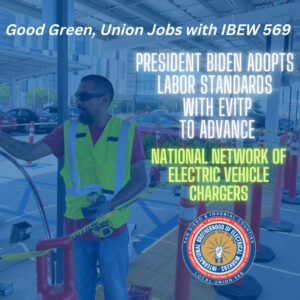The below paper was written by IBEW 569 member Kathleen Sax regarding labor history and toxic ‘Right-to-Work’ laws. We’re grateful to share her work with you and we encourage our members to get educated on the deceptions of ‘Right to Work’ and how it might destroy our rights in the workplace.
RIGHT TO WORK – “A Specious Title” and “Anti-Union Law”
“We must be on our guard against being fooled by false slogans, such as “right to work.” This high-sounding label does not mean what it says. It is a dishonest twisting of words with the aim of making a vicious law sound like a good law. It is a travesty on the true meaning of the word “right.” This so-called “right-to-work” law provides no “rights” and it provides no “work.” It is instead a law to rob us of our civil rights and job rights. It is an anti-union law. Its purpose is to destroy the labor unions and the freedom of collective bargaining by which the unions have improved the wages and working conditions of everyone. These so-called “right to work” laws, which are not right to work laws at all, have been enacted in the southern segregationist states in order to make a crime out of anyone trying to achieve the freedoms guaranteed by our Constitution and Bill of Rights. It is a whip to preserve the sharecropper wages and poverty system that has been used to keep working people in their place.” ~Dr. Martin Luther King
This was written by Dr. King, in a statement opposing the 1964 Oklahoma Right to Work Amendment. Dr. King, masterfully made the argument considering, the importance to fight against these laws. Unfortunately, the battle is not over.
This paper will provide a brief history of the labor movement. It will, also focus on the origins of the so-called, “right to work” laws, including how and why we must fight back.
What are Right to Work Laws?
Most of us understand the benefits we enjoy as members of a labor union. Union dues, payed by the members, help share the cost for all the benefits the union provides. Imagine each of us individually attempting to negotiate our wages and benefits with contractors. I don’t think we would get very far. Contractors and big business entities are well financed and have access to big Washington lobbying corporations that push for their interests. Our seat at the table is provided by our unions and is financed by the dues that we pay collectively. Right to work laws seek to prohibit union security agreements and collective bargaining agreements. These agreements help to solve the “free rider” problem where employees or members benefit from resources, goods, and services a union provides without paying for them. Right to work laws are government regulations of agreements between employers and labor unions that prevent unions from excluding non-union workers from paying dues. By undermining unions and the ability of labor to bargain freely, right to work laws weaken the best job security protection workers have, the union contract.
Republicans have pushed for these laws as early as the 1940’s. Now, with Republican control of the congress and the presidency, there is a renewed interest in passing a National Right to Work Law. Trump fashioned himself as an advocate of working people, while simultaneously supporting “right to work” legislation. He was quoted in The Examiner in February 2016, “I like right to work better. We’ve had great support from union workers, the people that work, the real workers, but I love the right to work. I like it better because it is lower. It is better for the people. You are not paying the big fees to the unions. The unions get big fees. I am talking about the workers. I like it because it gives great flexibility to the companies.” Trump, clearly, does not support workers. When union members vote for representatives that don’t support unions, it allows our adversaries to exploit our divisions.
The Labor Movement
The campaign against unions began before unions themselves. The labor movement has been fraught with struggles too numerous to address in this paper, however, in order to appreciate the importance of the fight against “right to work”, we must understand the struggle of those who came before us. One of the first examples of workers organizing is the Tolpuddle Martyrs of 1834. The Enclosure Acts began handing land over to rich land owners, that had been used, for centuries, by the poor for growing produce. Also, the new machines invented during the Industrial Revolution in England caused the price of labor to fall. The Industrial Revolution brought an influx of new workers who needed protection from greedy land owners. In an attempt to stop the plunge in wages, six men swore a secret oath and formed the Friendly Society of Agriculture. The Combination Acts of 1799 prohibited workers from organizing or “combining” into unions in order to gain better working conditions. When the existence of this society was revealed to the Prime Minister, the six men were convicted and sentenced to seven years transport, to work in penal servitude in New Wales, Australia. The community was not happy. One hundred thousand people demonstrated in London and signed a petition calling for the release of the men. Two years later, the workers were finally granted full pardons and returned in 1837. The community resisted the actions of the state, and won. The Combination Acts were repealed and unions were allowed to exist. This is a perfect example of people coming together and affecting change for the greater good of all.
There are few notable examples of union organizing in America until the Industrial Revolution. American trade unionism began with the formation of the Mechanics Union in Philadelphia in 1827. Craft unions joined together in the city and, in 1852 the International Typographical union emerged. The Industrial Revolution conflicted with labors ideology. The end of slavery brought into focus the rights of workers and the question of a fair wage. Advocates of equal rights began rolling out reform efforts. The National Labor Union and the Knights of Labor (KOL) flourished from the 1860-1880’s. They were committed to seeking the 8 hour work day, abolition of child labor, equal pay for equal work and the graduated income tax. Radical ideas for the time. Working conditions were dreadful and dangerous, and pay was low. Work hours were six days a week, 10-12 hours per day. The KOL suffered a major setback in 1886, when a strike at Haymarket Square, in Chicago, turned violent. The KOL were striking for better conditions when the police were called in to protect strikebreakers. One person was killed and several others were injured. A rally was planned the next day to protest police brutality. The gathering was peaceful, until police were sent into the crowd to force it to disperse. A pipe bomb was thrown into the police ranks and killed seven policemen and injured 60 others. The police then fired into the crowd, killing 4 people. In the end, eight protesters were convicted, even though some of the defendants were not even present at the rally. Nevertheless, three of them were hanged for conspiring with an unknown assailant. One of the men committed suicide before his execution date. This event produced hostility toward immigrants and labor leaders and delayed the adoption of the eight hour work day. The riot, also brought about the decline of the Knights of Labor. In December of 1886 Samuel Gompers united the Labor Union and the Knights of Labor to form the American Federation of Labor. The AFL maintained that it represented all workers, regardless of skill, race religion nationality or gender. Gompers led the AFL until 1924. He focused on issues such as wages, benefits, hours, and working conditions, all of which could be negotiated through collective bargaining. The organization grew from 150,000 to more than three million members in 1924. The AFL continues to achieve economic goals through national trade unions organized into networks of locals.
Labor leader John Lewis organized the committee for Industrial Organizations within the AFL, in 1935, to include industrial unions. The craft unions had a tendency to look down upon industrial workers, as unskilled. This contempt, led Lewis to withdraw from the AFL, in 1938. He, then, established the Congress of Industrial Organizations. The two groups remained separate until 1955 when they became the AFL-CIO. The largest labor organization in the world.
The Origins of Right to Work Laws
The following is a brief description of events that led up to the creation of right-to work laws. Following the Great Depression, the AFL was positioned to influence the federal government to pass labor laws favorable to workers. In 1935, the National Labor Relations Act (the Wagner Act) was passed. The purpose of the act was to establish the legal right of workers to organize or join labor unions, and bargain collectively with their employers. The Act set up a National Labor Relations Board (NLRB). The board had the power to resolve labor disputes. It also obligated employers to bargain collectively with unions. The board could correct unfair labor practices by employers and it prohibited employers from setting up company unions and discriminating against workers who joined unions. One of the main reasons the Wagner Act passed was because of the unity and cooperation that was fostered between the native born craftsmen and the immigrant and African American industrial workers in the north. They realized that they could achieve success if they combined their efforts and began voting for Democrats. They overcame the divisions that weakened the unions against corporate greed. Unity of the working class gave them the power to elect representatives that passed The Wagner Act, the most important union friendly legislation in American history. Unfortunately, The Taft-Hartley Act of 1947, undid much of the pro-union gains, of the Wagner Act, and set the stage for the so called right-to-work laws to gain momentum.
Support for the Wagner Act began to break apart when Southerners turned against it, less than one year later. The working class began to divide, while industry united. By 1938, divisions between the AFL and CIO created an environment that allowed Republicans to gain enough seats in Congress to produce a conservative movement. The conservative coalition was the product of the cohesion of the Southern Democrats. The Civil Rights Movement, at the time, also caused racial division that contributed to the decline of unions. By 1946, Republicans gained control of the Congress, for the first time in 18 years. This gave the conservative coalition the votes it needed to pass the Taft-Hartley Act in 1947, despite Truman’s veto. This Act severely impeded labors ability to establish unions in non-union sectors. Taft-Hartley outlawed the closed shop, which required workers to join the union before being eligible for employment. It prohibited mass picketing and secondary boycotts. Employers could now refuse to bargain and could propagandize workers through pamphlets, flyers and more recently, videos are used to avert employees from unionizing. The biggest blow to labor was the Taft-Hartley Act Section 14(b) because it legitimized right-to-work laws already passed in 11 states, and opened the flood gates for the rest of the states to pass these union killing laws, which greatly reduce membership and bargaining power.
In February 2017, in keeping with their usual anti-union tactics, Republican lawmakers introduced H.R. 785, the National Right to Work Act. This Act removes language that permits employers and unions to agree to require membership in a labor organization. This bill is radical because it “creates a federal mandate that overrides a state’s wishes by requiring private labor organizations to support free riders”, according to Congressmen Bobby Scott and Peter DeFazio. The Congressmen maintain that, “This legislation clearly has one purpose: to undermine the capacity of unions to protect workers and defund them. This bill is a direct attack on workers and their families, by weakening unions’ ability to collectively bargain and negotiate for good wages and benefits. Studies show that diminishing unions leads to lower wages, for union and non-union workers alike. This is why wages are lower in so-called right to work states, costing families thousands of dollars a year. Under federal law, no one can be forced to join a union as a condition of employment and the Supreme Court has made clear that workers cannot be forced to pay dues that are used for political purposes. The bill is a backdoor attempt to bankrupt labor unions, forcing them to provide services for people who do not pay dues. This bill is nothing more than a gift to anti-worker special interests.” This bill has gone unnoticed by many, I believe, due to the unprecedented events happening in Washington since Trump took office.
How We Fight Back
There are two major ways to fight against right to work laws. First, we need to vote for candidates that will advocate for legislation that supports unions. The union provides good paying jobs with benefits we need to support our families. In order to save the union we may have to vote for candidates with whom we don’t fully agree, on all issues. Republicans hijack the votes of working people and union members through fear of gun and abortion legislation. Once elected, politicians push for legislation that satisfies those that bankroll their campaigns, business entities and the wealthy. Labor costs are of utmost concern to these wealthy individuals and multinational corporations. Dismantling unions is an easy way to keep profits high by lowering worker pay and benefits. Many members support conservative representatives for moral reasons. It is worth mentioning that, in 1891, Pope Leo XIII took a clear moral stance, in support of unions, when he wrote Rerum Novarum (revolutionary change). This letter considered the relationship between labor and capital. It supported the rights of labor to form unions and declared that the role of the state is to promote social justice through the protection of rights. Trade unions were of particular interest in the document. “The most important of all are workman’s unions…it were greatly to be desired that they should become more numerous and more efficient.” Leo goes on to say that “Unions are severely part of the commonwealth and cannot be prohibited by public authority. To enter into a union of this kind is the natural right of man; and the state has to protect natural rights, not destroy them” (Rerum Novarum p.51). “The state should watch over these societies of citizens banded together in accordance with their rights, but it should not thrust itself into their organizations, for things move and live by the spirit inspiring them and may be killed by the rough grasp of a hand from without” (Rerum Novarum p.55). This paragraph is particularly valid now with the government attempting to insert itself into our unions by pushing Right-to-work legislation. Rerum Novarum had a significant impact, at the time, as a response to the exploitation of workers. Unions were beginning to gain momentum and importance, as a vehicle to level the playing field between workers and employers. The letter gave standing and legitimacy to the union movement. This document warrants review as inspiration to coalesce working people and fight the government’s specious right-to-work laws trending now.
It’s easy to take for granted the sacrifices union organizers, leaders and rank and file members made early on. It’s not enough to just go to our jobs and collect the pay check. The second action we have to take in order to save our union is to become more involved. We need to be less complacent and more engaged in union activities. We need to show up to meetings, stay informed or run for office. We have to fight if we don’t want our good paying jobs, benefits and pensions to disappear.
The Labor movement made lasting gains when they were unified. When the movement became divided the adversaries of labor exploited those divisions to chip away at workers’ rights and benefits. The only way to fight against right to work laws and win, is if we are united. Solidarity!


